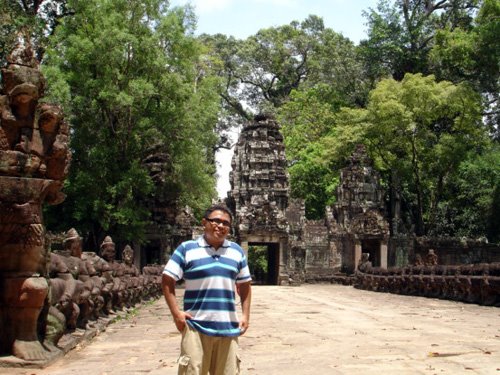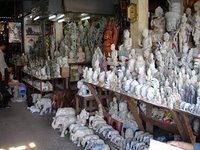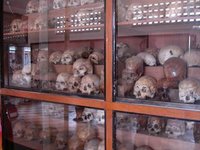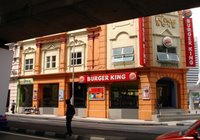Yesterday, I only went out for dinner. I had more Khmer food, this time beef amok which is a coconut milk based entree with vegetables. On the way home, I bought some jackfruit chips. Yummy! Hehe!
The service picked me up at the guest house at about 6:45 a.m. a while ago. We went to other guest houses to get the other passengers. I was expecting the vehicle we were going to use was a coaster. But I did not expect they were going to stuff it beyond capacity. Everyone on board was a foreigner and was complaining about being so cramped up. I was expecting I would be able to sleep. But I was wrong. The roads had potholes bigger than the moon's craters. For most of the way, it wasn't paved at all. The ordeal lasted six hours, with two stopovers in between.
We arrived at Poipet, the border town of Cambodia at about 1:45 p.m. I still had to endure lining up at immigration which was open-air, walking about a kilometer to the Thai border. It would have been ok, but by now, my bags were quite heavy. And the afternoon summer sun was just too much. Then we went through Thai immigration. And then we walked a few meters to where another bus would pick us up.
At least this was a much bigger bus and the roads were in much better condition. There was a store outside and the first thing I bought was cold water. Prices were much much cheaper here! Anyway, we were on our way at about 3:30 p.m. after close to two hours in transit. This time I was able to sleep better.
 About two hours away from Bangkok, we made another stopover. And this is where I was able to get some Thai street food. There was so much to choose from. Anyway, I got some sausages and machang. I was very much impressed by the road network in Thailand. Maybe the DPWH could learn a thing or two.
About two hours away from Bangkok, we made another stopover. And this is where I was able to get some Thai street food. There was so much to choose from. Anyway, I got some sausages and machang. I was very much impressed by the road network in Thailand. Maybe the DPWH could learn a thing or two.We arrived in Bangkok at about 8 p.m. There was a slight confusion as to where we were dropped off. Anyway, I called my SSEAYP roommate Sorawit Sangsuwan (Ton) who had been waiting for me at Kao San Road which was a tourist district.
 He treated me out for dinner at a Thai restaurant. And then, we went for a traditional Thai massage to get me back to my senses after that 12-hour ordeal. Thai massage is quite distinct in technique since it entails applying pressure for a few seconds in key points as well as stretching. At least that relaxed me a bit.
He treated me out for dinner at a Thai restaurant. And then, we went for a traditional Thai massage to get me back to my senses after that 12-hour ordeal. Thai massage is quite distinct in technique since it entails applying pressure for a few seconds in key points as well as stretching. At least that relaxed me a bit.I'm now in Ton's apartment where I'll be staying for the night. The campaign for the Thai Senate is ongoing. And there are a lot of campaign posters all over. But the thing I like about the campaign here is they don'ty use gawgaw. They don't put posters on walls or buildings or wherever. Candidates neatly mount their posters on sticks and place them in the soil. After the elections, it would be easy to clean up.
I'll meet more of my SSEAYP batchmates tomorrow. I've been to Bangkok several times before so I'm out to explore other places. If all goes well, I should be on my way to Vientiane in the evening.
My blog was featured in the Philippine Daily Inquirer today. Visit http://news.inq7.net/lifestyle/index.php?index=2&story_id=72206

































